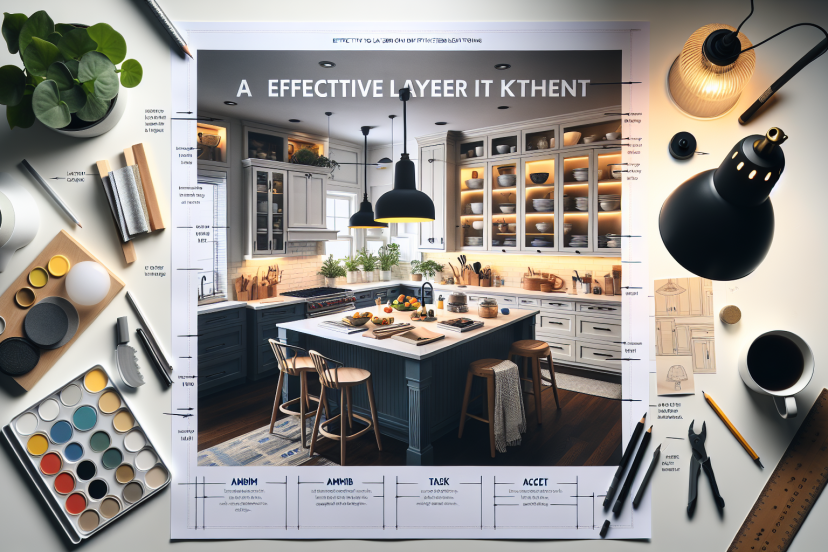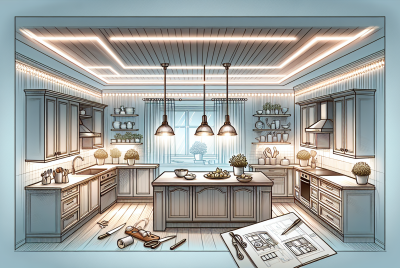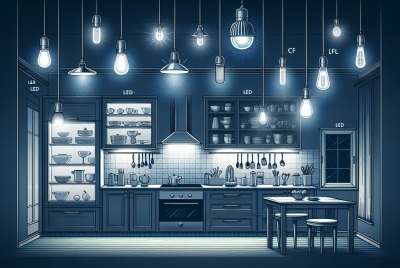Essential Tips For Properly Layering Kitchen Lighting
In designing your dream kitchen, don’t underestimate the power of proper lighting. Whether you’re an aspiring chef or just enjoy spending time in your kitchen, having the right lighting can make a world of difference. In this article, we will explore essential tips for properly layering kitchen lighting to create a warm and inviting space that is both functional and aesthetically pleasing. From task lighting to ambient lighting, we will guide you through the various layers you need to consider in order to illuminate your kitchen in the best possible way. So, let’s shed some light on how to transform your kitchen into a well-lit haven.
1. Understanding the Importance of Layered Lighting
When it comes to lighting design, layering is key. Layered lighting involves combining different types of lights at varying levels to create a well-balanced and visually appealing space. Not only does layered lighting enhance the overall aesthetics of your kitchen, but it also makes it more functional and safer to work in.
1.1 Creating Visual Interest
One of the main benefits of layered lighting is that it adds visual interest to your kitchen. By using different types of lights, you can create depth and dimension in the space. For example, you can use ambient lighting to provide overall illumination, task lighting to focus on specific areas like the countertop or kitchen island, and accent lighting to highlight architectural features or decorative objects. This combination of lights creates a visually pleasing environment that is both functional and stylish.
1.2 Enhancing Functionality
Layered lighting is not just about aesthetics; it also enhances the functionality of your kitchen. Each type of light serves a specific purpose. Ambient lighting provides overall illumination, ensuring that the entire space is well lit. Task lighting focuses on specific work areas, such as the food preparation area, making it easier and safer to chop, slice, and cook. Accent lighting highlights specific areas or objects, such as a beautiful backsplash or artwork, adding a touch of elegance to your kitchen. By incorporating these different types of lighting, you can create a space that is not only visually appealing but also highly practical for everyday use.
1.3 Maintaining Safety
Another crucial aspect of layered lighting is safety. In a kitchen, where sharp utensils and hot surfaces are common, proper lighting is essential to prevent accidents. Task lighting, such as under-cabinet lights or pendant lights above the kitchen island, ensures that you can see what you’re doing while working. This reduces the risk of cuts, burns, and other kitchen mishaps. By carefully planning the placement of lights and incorporating the right type of lighting, you can maintain a safe environment in your kitchen.
2. Types of Lighting to Consider
Now that you understand the importance of layered lighting, let’s dive into the different types of lighting you should consider for your kitchen.
2.1 Ambient Lighting
Ambient lighting, also known as general lighting, is the foundation of layered lighting. It provides overall illumination for the entire space and sets the mood of the room. Common types of ambient lighting include recessed ceiling lights, chandeliers, and flush mount fixtures. When choosing ambient lighting, consider the size and layout of your kitchen to ensure that the light is distributed evenly and effectively throughout the space.
2.2 Task Lighting
Task lighting is focused lighting that helps you perform specific tasks, such as cooking, cleaning, or reading recipes. It is essential to have ample task lighting in areas where you need clear visibility, such as over the stove, sink, or countertop. Under-cabinet lights, pendant lights, and track lighting are popular choices for task lighting in the kitchen. By properly illuminating your work areas with task lighting, you can work efficiently and safely.
2.3 Accent Lighting
Accent lighting adds a decorative element to your kitchen and highlights specific features or objects. It creates visual interest and adds a touch of style to your space. Common types of accent lighting include wall sconces, recessed spotlights, and strip lights. Use accent lighting to draw attention to architectural details, artwork, or display shelves. By strategically placing accent lights, you can create a warm and inviting atmosphere in your kitchen.
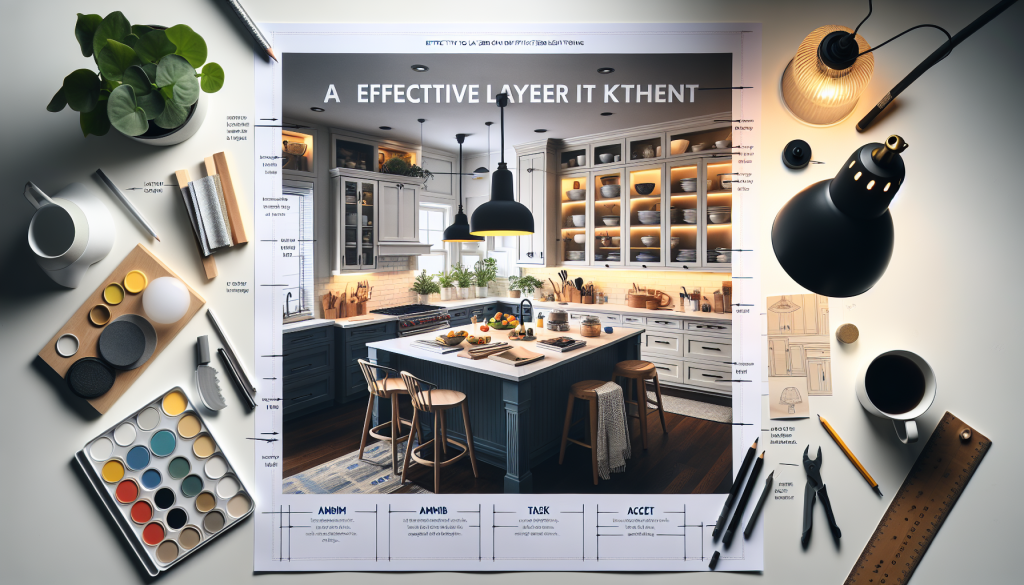
3. Planning the Placement of Lights
Now that you have a good understanding of the types of lighting available, it’s time to plan the placement of lights in your kitchen.
3.1 Identifying Key Areas
Start by identifying the key areas in your kitchen that require lighting. These areas typically include the countertops, stove, sink, kitchen island, and any other workspaces. Take note of any architectural features or decorative elements that you would like to highlight as well. By identifying these key areas, you can determine the type and quantity of lights needed for each space.
3.2 Determining Light Fixture Types
Once you have identified the key areas in your kitchen, consider the type of light fixtures that would work best for each space. For example, under-cabinet lights are ideal for illuminating countertops, while pendant lights are perfect for lighting up a kitchen island. Wall sconces can be used to highlight artwork or add a decorative touch. By selecting the right light fixtures for each area, you can create a cohesive and functional lighting design.
3.3 Considering Light Distribution
In addition to identifying key areas and selecting light fixtures, it’s crucial to consider the distribution of light in your kitchen. Make sure that the lighting is balanced throughout the space and that there are no dark corners or shadowed areas. Pay attention to the height and spacing of the lights to ensure even coverage. By carefully planning the distribution of light, you can create a well-lit and visually appealing kitchen.
4. Choosing the Right Light Fixtures
With the placement and distribution of lights planned, it’s time to choose the right light fixtures for your kitchen.
4.1 Determining the Wattage
When it comes to choosing the right light fixtures, one important factor to consider is the wattage. The wattage determines the brightness of the light. For ambient lighting, you’ll want a higher wattage to ensure that the space is well lit. Task lighting should have a moderate wattage to provide sufficient visibility, while accent lighting can have a lower wattage to create a softer and more intimate atmosphere.
4.2 Opting for Energy-Efficient Bulbs
In today’s environmentally conscious world, energy efficiency is a top priority. When choosing light fixtures, opt for energy-efficient bulbs such as LED or CFL. These bulbs consume less energy than traditional incandescent bulbs and have a longer lifespan. Not only will you save money on your energy bills, but you’ll also reduce your carbon footprint.
4.3 Selecting the Suitable Fixture Type
Consider the aesthetics of your kitchen when selecting light fixtures. Choose fixtures that complement the style and decor of your kitchen, whether it’s modern, traditional, or eclectic. Ensure that the size and scale of the fixtures are appropriate for the space as well. By selecting light fixtures that blend seamlessly with your kitchen’s design, you can create a cohesive and visually stunning lighting scheme.
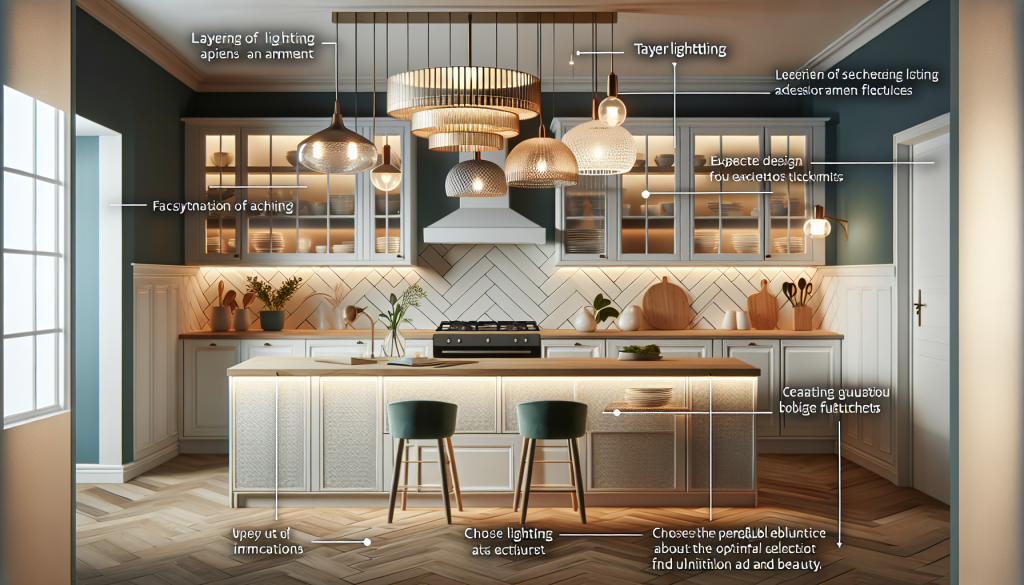
5. Understanding Color Temperature
When it comes to lighting design, color temperature plays a vital role in setting the mood and ambience of your kitchen.
5.1 Differentiating Warm and Cool Lights
Color temperature is measured in Kelvin (K) and can be categorized as warm or cool. Warm lights have a lower Kelvin value, typically ranging from 2200K to 3000K, and emit a cozy and inviting glow. Cool lights have a higher Kelvin value, usually ranging from 4000K to 5000K, and give off a bright and energizing light. When selecting light bulbs, consider the mood and atmosphere you want to create in your kitchen.
5.2 Creating the Desired Ambience
The color temperature of your lighting can greatly impact the overall ambience of your kitchen. Warm lights are often preferred in kitchens as they create a welcoming and intimate atmosphere, perfect for entertaining or relaxing with a cup of coffee. Cool lights, on the other hand, are ideal for task-oriented areas, where bright and focused lighting is needed. By understanding the different color temperatures and their effects, you can create the desired ambience in your kitchen.
6. Controlling Lighting Levels
Controlling the lighting levels in your kitchen is essential to create the right atmosphere and meet your specific needs.
6.1 Using Dimmers
Dimmers are a great tool for adjusting the brightness of your lights. They allow you to control the intensity of the light, providing flexibility and customization. Dimmers are especially useful in areas where you require different levels of lighting, such as the dining area or kitchen island. By installing dimmers, you can easily transition from bright task lighting to softer ambient lighting, depending on the occasion or time of day.
6.2 Implementing Zoning or Groups
To further enhance the flexibility of your lighting, consider implementing zoning or grouping. This involves dividing your kitchen into different zones and controlling the lights in each zone independently. For example, you could have one zone for task lighting above the countertop and another zone for ambient lighting above the dining area. By creating separate zones, you can customize the lighting in each area according to its specific function.
6.3 Incorporating Smart Lighting Technology
Take your lighting control to the next level by incorporating smart lighting technology. Smart lighting allows you to control your lights remotely using a smartphone or voice commands. You can adjust the brightness, color temperature, and even create lighting schedules to match your daily routines. Smart lighting systems also offer energy-saving features, such as motion sensors and automated timers. By embracing smart lighting technology, you can have complete control over your kitchen lighting, enhancing convenience and energy efficiency.
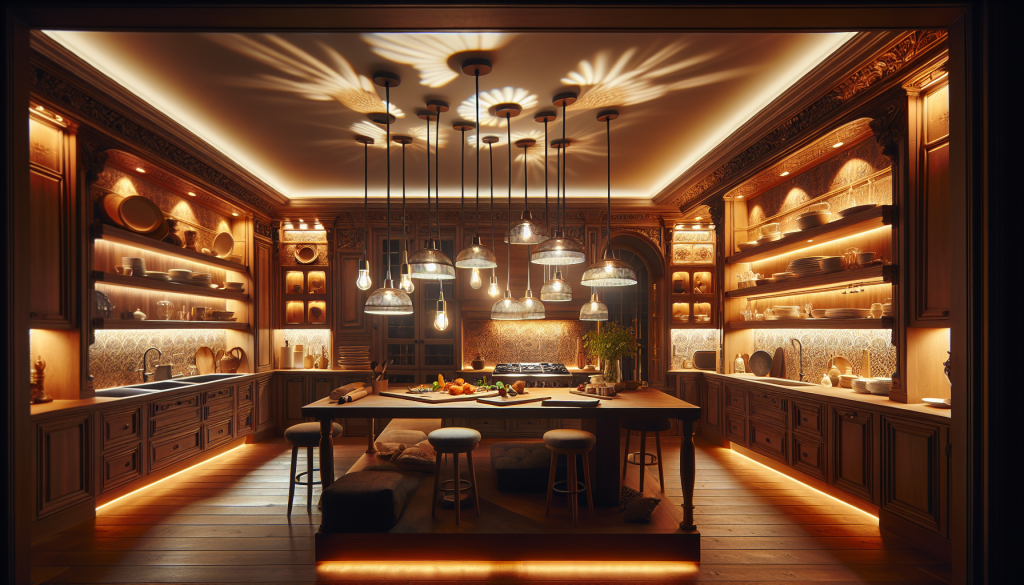
7. Balancing Lighting Design
Achieving a well-balanced lighting design involves harmonizing different types of lighting and avoiding common pitfalls.
7.1 Harmonizing Different Types of Lighting
To create a cohesive lighting design, it’s essential to harmonize different types of lighting. The ambient, task, and accent lighting should work together seamlessly to provide a balanced and visually appealing result. This can be achieved by ensuring that the intensity and color temperature of the lights are consistent throughout the space. Pay attention to the placement and distribution of the lights to avoid any glaring or shadowed areas.
7.2 Avoiding Glare or Shadows
Glare or shadows can hinder the effectiveness and aesthetics of your lighting. To avoid glare, position lights away from reflective surfaces, such as glossy countertops or stainless steel appliances. Use diffusers or frosted bulbs to soften the light and reduce glare. Shadows can be minimized by placing lights strategically and using a combination of ambient, task, and accent lighting. By eliminating glare and shadows, you can create a well-lit and comfortable kitchen environment.
7.3 Considering High Ceilings
If you have high ceilings in your kitchen, it’s essential to take them into account when planning your lighting design. High ceilings can make the space feel cavernous and leave areas in shadow. To overcome this, consider using pendant lights or chandeliers that hang lower to illuminate the area below. Additionally, recessed lighting can be used to provide even illumination throughout the space. By considering the height of your ceilings, you can ensure that your lighting design is effective and visually appealing.
8. Incorporating Natural Light
In addition to artificial lighting, incorporate natural light into your kitchen design for a fresh and inviting atmosphere.
8.1 Maximizing Natural Light Sources
Maximizing the use of natural light can help reduce energy consumption and create a vibrant ambiance in your kitchen. If possible, position your kitchen in a location that receives ample natural light throughout the day. Utilize large windows, skylights, or glass doors to allow natural light to flood into the space. You can also incorporate light-colored or reflective surfaces to bounce the natural light around the room. By maximizing natural light sources, you can create a bright and airy kitchen environment.
8.2 Managing Sunlight Exposure
While natural light can be beneficial, it’s important to manage the exposure of sunlight in your kitchen. Direct sunlight can cause heat buildup and fade surfaces over time. Consider using window treatments, such as blinds or curtains, to control the amount of sunlight entering the space. If you have windows that face east or west, opt for treatments that diffuse the light while still allowing natural light to enter. By managing sunlight exposure, you can protect your kitchen and maintain a comfortable temperature.
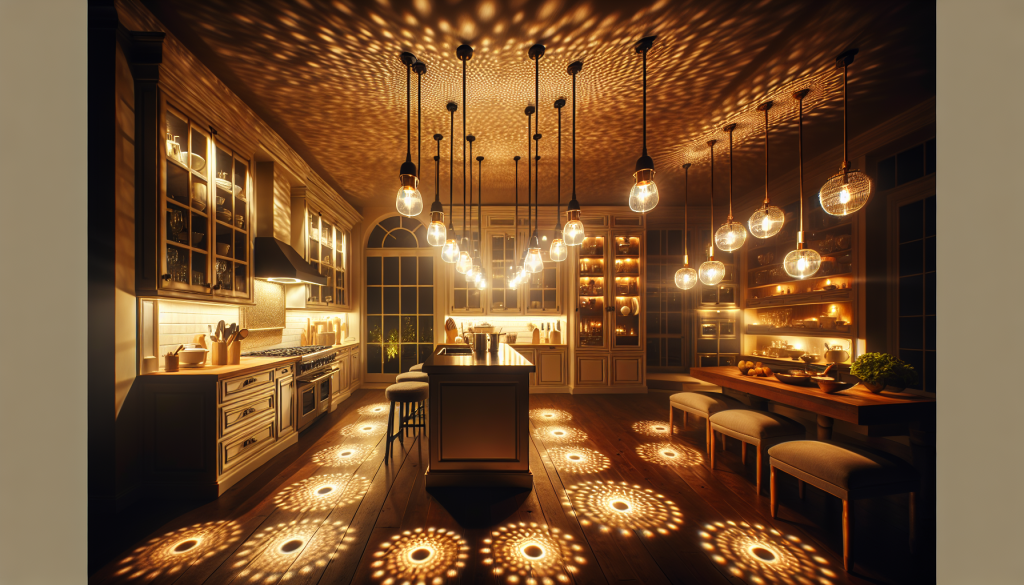
9. Addressing Safety Concerns
In any lighting design, safety should be a top priority. Take the necessary precautions to ensure that your kitchen lighting is safe and in compliance with electrical codes.
9.1 Following Electrical Codes
Before installing any lighting fixtures, familiarize yourself with the electrical codes in your area. Electrical codes dictate the proper installation, wiring, and safety requirements for lighting fixtures. If you are uncertain or uncomfortable with electrical work, consult a licensed electrician to ensure compliance with the codes. By following the electrical codes, you can create a safe and reliable lighting system in your kitchen.
9.2 Ensuring Proper Fixture Installation
Proper installation of light fixtures is crucial to ensure their safety and performance. Make sure that all fixtures are securely mounted and that the wiring is done correctly. If you are unsure about the installation process, it’s best to seek professional help from a licensed electrician. Improperly installed fixtures can pose a fire hazard and cause other electrical issues. By ensuring proper fixture installation, you can enjoy a safe and reliable lighting system in your kitchen.
9.3 Properly Grounding Electrical Components
Grounding is an essential safety measure that protects against electrical shocks and surges. Ensure that all electrical components, including light fixtures, are properly grounded. Grounding involves connecting electrical equipment to a grounding conductor, preventing the buildup of excess electrical charge. If you are unsure about grounding requirements or procedures, consult an electrician for guidance. By properly grounding electrical components, you can minimize the risk of electrical accidents in your kitchen.
10. Consulting with Professionals
When it comes to lighting design, it’s always beneficial to seek expert advice and assistance.
10.1 Seeking Expert Advice
If you are unsure about the technical aspects of lighting design, consider seeking advice from professionals who specialize in lighting. Lighting designers or interior designers can provide valuable insights and help you create a customized lighting plan for your kitchen. They can assist with selecting the right fixtures, planning the placement and distribution of lights, and ensuring compliance with electrical codes. By consulting with experts, you can achieve a well-designed and professionally executed lighting system.
10.2 Hiring a Licensed Electrician
For any electrical work involved in your lighting design, it’s crucial to hire a licensed electrician. They have the knowledge, skills, and expertise to safely install and wire the light fixtures. An electrician can ensure that the electrical work meets the required safety standards and codes. Hiring a licensed electrician not only ensures the safety of your lighting system but also gives you peace of mind. By working with a professional, you can avoid potential hazards and enjoy a professionally installed and reliable lighting system in your kitchen.
In conclusion, properly layering kitchen lighting is essential for creating visual interest, enhancing functionality, and maintaining safety. By considering different types of lighting, planning the placement and distribution of lights, choosing the right fixtures, understanding color temperature, controlling lighting levels, balancing the lighting design, incorporating natural light, addressing safety concerns, and consulting with professionals, you can create a well-designed and functional lighting scheme in your kitchen. So, take these essential tips into account and illuminate your kitchen with style and efficiency.

